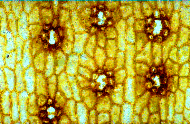Fossil
Plant Cuticles

Pseudovoltzia
liebeana |
 |
The cuticle is the outer protective layer which covers the aerial green
parts of higher land plants. The cuticle clearly displays the cell pattern of the
underlying epidermis including features such as stomata and glands. This
cell pattern is very distinctive and each plant species has its own
characteristic cuticle. Cuticles are very resistant and the oldest known
cuticles are over 400 million years old. Especially in compression floras
cuticles are often the only source of cellular information.
|
In addition to their usability for identifying fossil plants on a biological
basis, fossil cuticles provide important information about palaeoecology and
palaeoclimate. Important features include the position and density of
stomata, the thickness of the cuticle, and the presence of hairs and glands.
Several research projects on fossil cuticles are currently running in
Münster. One project deals with seed fern and cordaite
cuticles fromthe Stephanian (Upper Carboniferous) of Western and Central Europe, focusing
on material from the French Massif Central. Special attention is also given
to cuticles of the Early Devonian Rhynie Chert
plants. In addition cuticles of Carboniferous and Permian plants from
various regions in Europe and North America are studied. Cooperations with
organic geochemists have led to a better insight in the chemistry of fossil
and recent cuticles.